Related Research Articles
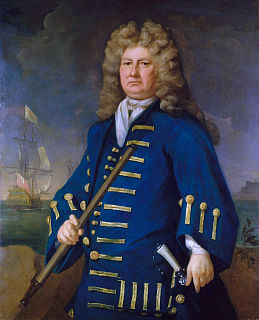
Admiral of the Fleet Sir Cloudesley Shovell was an English naval officer. As a junior officer he saw action at the Battle of Solebay and then at the Battle of Texel during the Third Anglo-Dutch War. As a captain he fought at the Battle of Bantry Bay during the Williamite War in Ireland.

Association was a 90-gun second-rate ship of the line of the Royal Navy, launched at Portsmouth Dockyard in 1697. She served with distinction at the capture of Gibraltar, and was lost in 1707 by grounding on the Isles of Scilly in the greatest maritime disaster of the age. The wreck is a Protected Wreck managed by Historic England.
HMS Somerset was a three-decker 80-gun third rate ship of the line of the Royal Navy, launched at Chatham Dockyard on 31 May 1698. She was the first ship to bear the name.

HMS Charles was a 96-gun first-rate ship of the line of the Royal Navy, built by Christopher Pett at Deptford Dockyard until his death in March 1668, then completed by Jonas Shish after being launched in the same month. Her name was formally Charles the Second, but she was known simply as Charles, particularly after 1673 when the contemporary Royal Charles was launched.
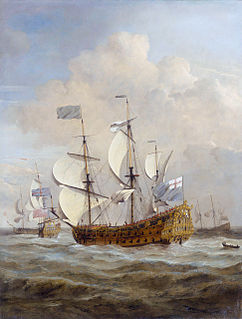
HMS St Andrew was a 96-gun first-rate ship of the line of the Royal Navy, built at Woolwich Dockyard under the supervision of Christopher Pett until his death in March 1668, completed by Jonas Shish, and launched in 1670. Commanded by George Churchill, she took part in the 1692 victory over the French navy at Barfleur & La Hogue.
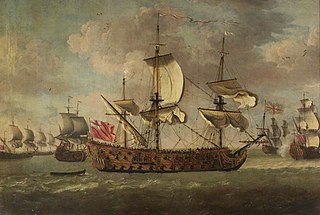
HMS Swiftsure was a 70-gun third-rate ship of the line of the Royal Navy, built by Sir Anthony Deane at Harwich, and launched in 1673. By 1685 she had been reduced to a 66-gun ship.

HMS Eagle was a 70-gun third rate ship of the line of the Royal Navy, launched at Portsmouth Dockyard on 31 January 1679.
HMS Torbay was an 80-gun third rate ship of the line of the Royal Navy, launched at Deptford Dockyard on 16 December 1693. In 1707, she served as flagship of Rear-Admiral of the Blue Sir John Norris and belonged to Admiral Sir Cloudesley Shovell's fleet. She saw action during the unsuccessful Battle of Toulon and was present during the great naval disaster off the Isles of Scilly when Shovell and four of his ships were lost, claiming the lives of nearly 2,000 sailors. Torbay suffered little to no damage and finally managed to reach Portsmouth.

HMS Orford was a 70-gun third-rate ship of the line of the Royal Navy, launched at Deptford in 1698. She carried twenty-two 24-pounder guns and four (18-pounder) culverins on the lower deck; twenty-six 12-pounder guns on the upper deck; fourteen (5-pounder) sakers on the quarter-deck and forecastle; and four 3-pounder guns on the poop or roundhouse.
Firebrand was a Royal Navy fireship built at Limehouse in 1694, the first Royal Naval vessel to bear the name.

HMS Romney was a 50-gun fourth rate ship of the line of the Royal Navy, launched at Blackwall Yard on 23 October 1694.
HMS Panther was a 50-gun fourth rate ship of the line of the Royal Navy, built at Deptford Dockyard and launched on 15 March 1703.
HMS Phoenix was originally built as a fireship. In 1707, she belonged to Admiral Sir Cloudesley Shovell's fleet. She saw action during the unsuccessful Battle of Toulon and was present during the great naval disaster off the Isles of Scilly when Shovell and four of his ships were lost, claiming the lives of nearly 2,000 sailors. Phoenix ran ashore between Tresco and St Martin's and had to be beached, but could be kept seaworthy and finally managed to reach Portsmouth. In 1709, the former fireship was re-built as a 20-gun sixth-rate frigate. When under the command of Vincent Pearse, she sailed to Nassau, Bahamas in February 1718, to offer the king's pardon to pirates who were willing to surrender and abandon piracy. She also played a minor role in the 1740 Siege of St. Augustine during the War of Jenkins' Ear. In 1741, under the command of Captain Fanshaw, she was involved in the defence of Charlestown, South Carolina from Spanish pirates.

St Mary's Old Church, St Mary's is a parish church in the Church of England located in Old Town on St Mary's, Isles of Scilly, Cornwall, United Kingdom.
HMS Sapphire was a 32-gun fifth rate of the Royal Navy.

The Scilly naval disaster of 1707 was the loss of four warships of a Royal Navy fleet off the Isles of Scilly in severe weather on 22 October 1707. Between 1,400 and 2,000 sailors lost their lives aboard the wrecked vessels, making the incident one of the worst maritime disasters in British naval history. The disaster has been attributed to a combination of factors, including the navigators' inability to accurately calculate their positions, errors in the available charts and pilot books, and inadequate compasses.

The Naval Air Command Sub Aqua Club (NACSAC) was an organisation within the Royal Navy that oversaw sports and technical diving training activities for naval aviation and fleet units. Today it has branches at RNAS Culdrose and RNAS Yeovilton. Both bases provide training, and club members regularly dive in their local areas on weekends. Diving instruction, from beginner to advanced level, is offered under the auspices of the British Sub-Aqua Club. In 2005 NAC-SAC was closed down as an organisation in favour of a Royal Navy Sub Aqua Club, which is what Lieut. Graham and CPO Larn had wanted from the outset of NAC-SAC which was only given that title since HMS Vernon, the RN Diving School at Portsmouth, would not support the idea of sport diving within the service.
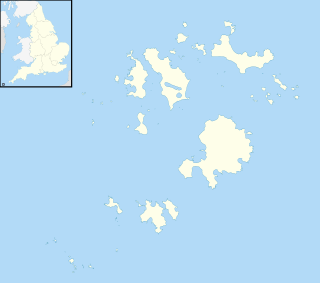
The Western Rocks are a group of uninhabited skerries and rocks in the south–western part of the Isles of Scilly, United Kingdom, and are renowned for the numerous shipwrecks in the area and the nearby Bishop Rock lighthouse. In 1971, the rocks and islands were designated a Site of Special Scientific Interest for their breeding sea birds. Landing on the islands is both difficult and discouraged and there are few published records of visits by naturalists.
Richard James Vincent Larn, OBE is a retired Chief Petty Officer in the Royal Navy, a businessman and maritime history writer who is widely regarded as one of Britain's leading historic shipwreck experts.
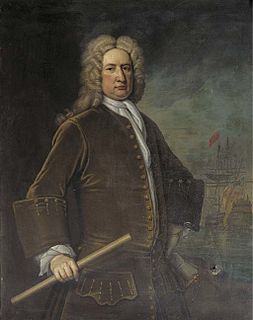
John Baker was an officer of the Royal Navy and politician who sat in the House of Commons between 1713 and 1716. He rose to the rank of vice-admiral after service in the Nine Years' War and the War of the Spanish Succession.
References
- ↑ Historic England. "Details from listed building database (1000063)". National Heritage List for England .
- 1 2 3 "TEARING LEDGE - 1000063 | Historic England". historicengland.org.uk. Retrieved 2020-10-13.
- ↑ "Tearing Ledge". Virtual Dive Trails. Retrieved 2020-10-13.